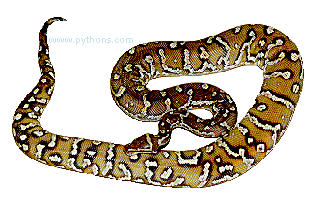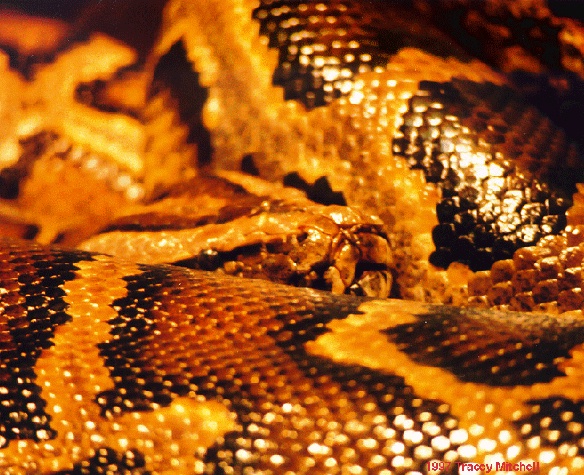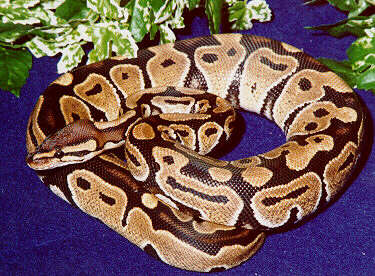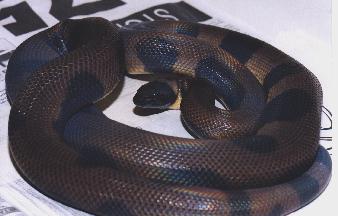
All pythons are carivores. The smallest and basic starter food for them is pinkie mice. Some pythons once they have fully grown can eat a pig and in the wild a rock python was pictured eating an antelope. Before getting one as a pet you need to know how much and how fast they grow, they range from 5 to 30 feet. All pythons are stout full bodied.
In the world of snakes , the boas and pythons are real old timers. They have been around with few changes for 70 to 100 million years.
The boids are among only a few snakes that retain traces of legs. If you inspect the cloacal openings of these animals, "spurs" can be seen. These claws are the remains of back legs and are attached to the pelvic girdle.
In days of old. Some boids may have reached lengths of 50 to 100 feet, today a really large reticulated python mignt reach 30 feet or a little more.
In general these make good pets because they are hardy and easy to maintain, plus if taken care of well can live 20 to 30 years. They have been in the pet trade for a long time, but know what your getting. Examine it before you purchase and find out if breed in captivity or wild. Breed in captivity is the best to pick for several reasons. The main one to me is that they are not being over collected when you buy breed ones, plus it is more healthy in these cases.
Most pythons are easy to care for if you understand all of their needs such as temperature, diet, and habitat. But some pythons although they look almost exactly like their kin are not easy to care for and habitat for them is very different. In the case of a ball python they are a good python for beginners in the python family to where blood pythons (even those that have had pythons in the past) can end up not informed enough about their habitat to end up with your pet dieing. So even though the names are close and their looks very simular and a store clerk telling you they are the same, beware and even the experiences should read up when the pet isn't something you have already owned exactly. Of course the differences in an albino is not a difference other than appearance so an albino ball python needs the same as a ball python except because of the pigment sensitivity they will want to have less light. This doesn't mean no light, just less, so you might want to go with a bit warmer heat element. A good light for all reptiles are the bulbs that are specially designed for repiles and give off the UV rays that reptiles need, they might cost more but then keeping exotic pets is never a cheap pet. Also all reptiles need special vitamins so you should also be sure to do this as well. The vitamins I use are in powder form and every other feeding I sprinkle it onto its food.
 ANGOLAN PYTHONThe Angolan Python is one of the rare types of pythons, most pythons have been captive breed and there is plenty of them( in captivity).
ANGOLAN PYTHONThe Angolan Python is one of the rare types of pythons, most pythons have been captive breed and there is plenty of them( in captivity).
This one is being breed in captivity and sold but their numbers are unsure in the wild..the term rare is use for the ones in the wild.
INDIAN PYTHON

The Indian Python looks very much like the burmese python an easy way to tell them apart is the incomplete "arrowhead" marking on the tops of their heads, the one on the indian python fades out but the one on the burmese is defined.Also this one is lighter in color compared to the burmese.
The Indian Python is also on the endangered species as the picture I selected shows plus also shows where it comes from. Some times you might run into a pet shop that says it has a indian python for sale...more than likely this is a cross breed.
WATER PYTHON
 The picture here is of a Juvenile New Guinea Water python.
The picture here is of a Juvenile New Guinea Water python.
Some water pythons are as nice as a snake can get while others may be very nervous and irritable captives. In general it seems that New Guinea specimens and northeastern Queensland specimens are calmer than are the Northern Territory specimens. Most water pythons are snappy as youngsters and then become more calm as they mature. There are very few New Guinea specimens in captivity in the world. It appears to us, based on the few specimens that we’ve had the opportunity to maintain, that New Guinea water pythons are smaller and more slender than their Australian conspecifics. VPI accomplished the first captive breeding of the New Guinea water pythons.
The Water Pyton from Africa is endangered and the only species that exist are in captivity. The only other information I have been able to find was a clipping about a mating pair being stolen from a zoo where they have lived for several years.
BURMESE PYTHON
 The Burmese Python is one of the most popular of the pet trade, but you must know that they are capable of growing up to 20 feet long and they grow fast. Also popular is the albino burmese and they are also easy to obtain in pet stores.
The Burmese Python is one of the most popular of the pet trade, but you must know that they are capable of growing up to 20 feet long and they grow fast. Also popular is the albino burmese and they are also easy to obtain in pet stores.Cross breeds other than albinos are also available such as the green patternless. I have also seen a totally white burmese but it was not an albino because it has black eyes. It is a one of a kind but the person that breed it is now tring to breed it with others in hope that some of the babies will be solid white as the female is. So far this has not happen.
BALL PYTHON

 The Ball Python(also called the royal python) is also very popular for a pet. It only grows up to around 6 feet is taken care of rather easy, the only problems is when you first get them it might have a problem eating. Turn out there lights when first feeding them because they are night feeders.
The Ball Python(also called the royal python) is also very popular for a pet. It only grows up to around 6 feet is taken care of rather easy, the only problems is when you first get them it might have a problem eating. Turn out there lights when first feeding them because they are night feeders.When treatened these snakes usually will ball up instead of striking, thus the name.
There are also albino ball pythons but their availablity in pet shops are limited but growing.
RETICULATED PYTHONThe Reticulated Python is an Asian species .This snake is also popular as a pet but keep in mind that these snakes have grown to over 33 feet, in captivity its normal to grow to around 18 to 20 feet and they are very heavy , this is not a snake recommended for the beginner.
Albino Reticulated Pythons have been on display but I haven't seen them for sale yet.
 DIAMOND PYTHONThe Diamond Python(also called the carpet python)are very sought after and beautiful species.They are from Australia.
DIAMOND PYTHONThe Diamond Python(also called the carpet python)are very sought after and beautiful species.They are from Australia.These snakes are primarily nocturnal and semi-arboreal. They seem to prefer the heavily wooded ares.
There are four subspecies in all. They can grow up to 10 feet and are fairly stout.
Their perferred diet is lizards but may take small mammals and birds too.
ROCK PYTHON The Rock Python is the largest of the African pythons. They range from 10 to 20 feet and are seldom found far from water and they are excellent swimmers.
The diet includes mostly small mamals and birds the lage specimens can take prey up to the size of a large wart hog. I seen a picture of one eating an antelope.
This species is a fairly aggressive animal by nature. That might be one reason for the lack of interest in their captive propagation. Their size and general 'attitude" tend to make this another snake that might not make the best choice for a novice herp keeper.
 CHILDREN'S PYTHONThe Children's Python is from Australia and is being sought by American keepers.
CHILDREN'S PYTHONThe Children's Python is from Australia and is being sought by American keepers.
Children's pythons are readily bred in captivity and usually mate in the winter. They will seldom exceed 4 to 5 feet long.
This is a great little python that thrives in captivity. It has been well-established in U.S collections for decades. They’re docile and fun to work with, and they are a great species for new python keepers to learn the basics of captive-breeding.
 RINGED PYTHONThe Ringed Python is a beauty. This is also a good snake for a pet because of there smaller size, they don't pass being 10 feet long.
RINGED PYTHONThe Ringed Python is a beauty. This is also a good snake for a pet because of there smaller size, they don't pass being 10 feet long. This is a picture of a baby. As in most all reptiles the babies are brighter and more colorful than the adults.
This is a picture of a baby. As in most all reptiles the babies are brighter and more colorful than the adults.
 Also as you can see from this set of ring pythons the patternes can range quite a bit but both are still striking in color.
Also as you can see from this set of ring pythons the patternes can range quite a bit but both are still striking in color. CAPE YORK SPOTTED PYTHONSpotted pythons are closely related to the Children's python, with slightly larger size and markings of greater contrast. Like the Children's, this is also a good python for beginners.This Cape York color phase, with its high contrast yellow and brown coloration, is rare in captivity.
Adult size -36 inches.
CAPE YORK SPOTTED PYTHONSpotted pythons are closely related to the Children's python, with slightly larger size and markings of greater contrast. Like the Children's, this is also a good python for beginners.This Cape York color phase, with its high contrast yellow and brown coloration, is rare in captivity.
Adult size -36 inches. GREEN TREE PYTHON The green tree python is a beautiful snake the as offsprings range in color. But when they finish maturing they usually go green, but some have been seen at having a blue tint instead of green.
GREEN TREE PYTHON The green tree python is a beautiful snake the as offsprings range in color. But when they finish maturing they usually go green, but some have been seen at having a blue tint instead of green.
All tree snakes wheather pythons or boas are not for the beginner. They not only have fangs they have double fangs and they are extra long because their diet is mostly birds, they catch them as they fly past. They are very aggressive but people that have owned them say they are good pets but you have to take your chances. They are breed for sale so you probably won't get one that is wild as long as you stick to buying babies, this makes it alittle easier for them to get to know you and not bite..but even the best pet can bite.


JUNGLE CARPET PYTHON
This is a medium-sized slender python with a long neck and a big head much broader than the neck. The head is covered in small scales and the lips are prominently pitted. Hatchlings are monochromatic, patterned in black and gray; subadults can be stunning yellow or gold on black; adults tend to add a black sootiness to the yellow areas of pattern as they age, some older adults become very dark. Some specimens have a pale vertebral stripe. The head has a well-defined pattern, often a skull-and-crossbones.
Average adult size: 56"-80"

The pictures I have used here in this page I copied from a couple of places and these images are to veiw for their sale. If you like to own snakes and find one of these to be captivating check out the homepages they come from.
EXOTIC UNLIMITED
HANSFORD REPTILE BREEDING CENTER

This page hosted by